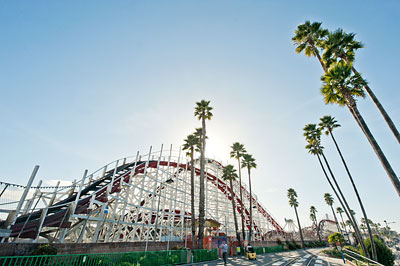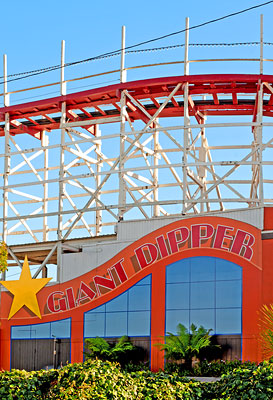National Register of Historic Places in Santa Cruz County
Looff Carousel and Giant Dipper Roller Coaster
Santa Cruz Beach Boardwalk
Beach Street and Leibrandt Avenue
Santa Cruz
In 1904, Fred W. Swanton, a great promoter, laid plans for a casino and boardwalk patterned after those at Coney Island. His Neptune Casino operated only until 1906, when it was destroyed by fire.
Undeterred, Swanton retained architect William W. Weeks, who drew plans that included a new casino, an indoor swimming pool or natatorium, a pleasure pier and a boardwalk. The new facilities opened in June 1907.
The next year, the first thrill ride opened, Thompson Scenic Railroad, a miniature train with small hills of a roller coaster type that ran through the area presently occupied by the Giant Dipper.
In 1911, the Boardwalk acquired its carousel from the Long Beach factory of Charles Looff, one of the nation's foremost carousel carvers. Looff built his first carousel at Coney Island in 1876. He was probably the first person in the United States to carve carousel horses and to make their frames. Although he did not build nearly the number of carousels that other manufacturers did, his work was noted for its quality.
In 1924, Looff's son persuaded the Boardwalk's owners to replace the Scenic Railway with the Giant Dipper roller coaster. That same year, the first Miss California Pageant was held at the Boardwalk, and the winner went on to become Miss America.
The Giant Dipper is a classic wooden twister-type coaster with sweeping fan curves, providing a half-mile ride. Its arches reach a maximum height of 75 feet. Its basic structure and form are intact, although some wood has been incrementally replaced for safety reasons.
The Santa Cruz Beach Boardwalk is the last major operating seaside boardwalk-amusement park on the Pacific Coast.
Adapted from the NRHP nomination submitted in 1987.

